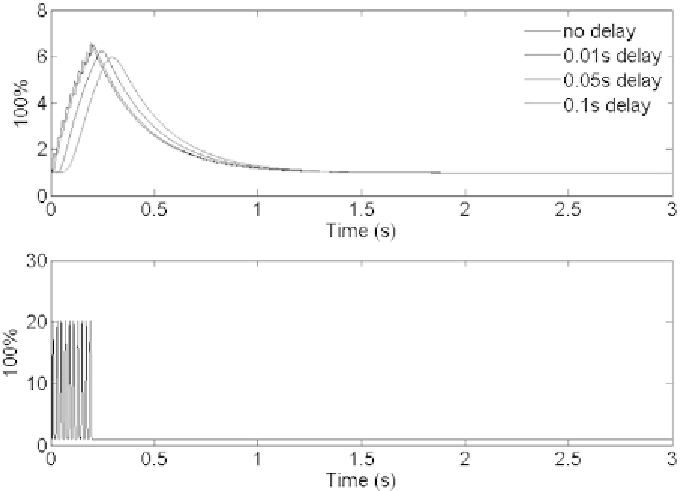Biology Reference
In-Depth Information
Fig. 4. Effects of different delays on dopamine signaling. Lower panel: Train of 10 signals with
w
1
=
0.01s
w
2
=
0.01s, and
bolus
=
20. Upper panel: The response to the signal train is a single, extended peak of extracellular dopamine (DA-e). The
peak is ragged for no or small delays, but essentially smooth for longer delays.
RESULTS
Effects of different delays
Most steps in the dopamine signaling system are biochemical reactions, and therefore fast. In com-
parison, the movement of vesicles, their attachment to the presynaptic membrane, and the subsequent
release of dopamine into the synaptic cleft are slower. As detailed in the Methods section, we model
this relatively slow process with a time delay [22]. Zhang and coworkers [23] suggested that the most
relevant range for this delay is between tens and a few hundred milliseconds. We investigated the effects
of different delays within this range in two typical signaling scenarios, as shown in Figs 4 and 5.
When the distance between subsequent signals and the signal width are equal or similar (e.g.,
w
1
=
0.01s and
w
2
=
0.01s in Fig. 4), the extracellular dopamine accumulates in the form of a single extended
peak, consisting of a fast rise and a relatively slow return to the baseline.
If the distance between two consecutive signals is much greater than the signal width (e.g.,
w
1
=
0.01s
and
w
2
=
0.2s in Fig. 5), the dopamine responses consist of individual, separated peaks.
As demonstrated in Figs 4 and 5, the dopamine system with realistic delays has the following features:
1. The larger the delay is, the more the peaks of response are reduced in height.
2. The larger the delay is, the less the valleys between peaks are pronounced.
These two features imply that large delays may lead to impairments in the efficiency of the signaling
system and that it is possible that signals are lost in the process. Although the delayed responses may have
a similar appearance as the responses in the non-delayed system, it is possible that the delayed responses
no longer exceed the necessary threshold that is typical for signal transduction in all-or-nothing responses

